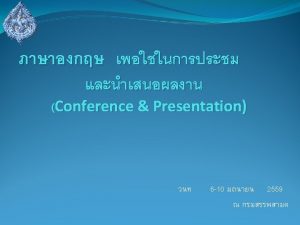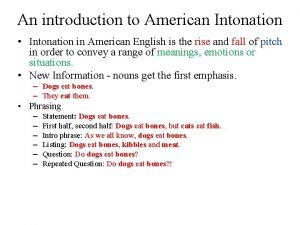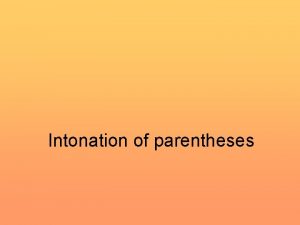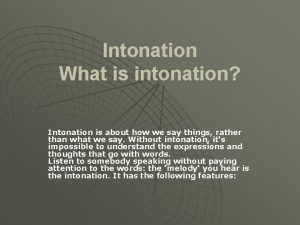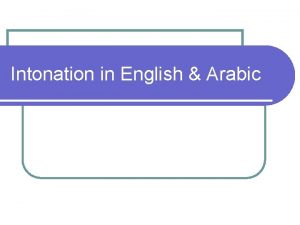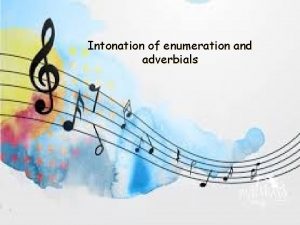An introduction to American Intonation Intonation in American












- Slides: 12

An introduction to American Intonation • Intonation in American English is the rise and fall of pitch in order to convey a range of meanings, emotions or situations. • New Information - nouns get the first emphasis. – Dogs eat bones. – They eat them. • Phrasing – – – Statement: Dogs eat bones. First half, second half: Dogs eat bones, but cats eat fish. Intro phrase: As we all know, dogs eat bones. Listing: Dogs eat bones, kibbles and meat. Question: Do dogs eat bones? Repeated Question: Do dogs eat bones? !

American Intonation: Compound Nouns • adjective with noun: stress • Practice these. the noun • It's a pot. – a nice guy – a big house – a good idea • A compound noun : stress the first word – a hot dog – a notebook – a picture frame • This explains why we say: – He lives in a white house. – He lives in the White House. It's new. It's a new pot. It's brand new. It's a brand new pot. It's a tea pot. It's a new tea pot. It's a brand new tea pot. It's a tea pot lid. It's a new tea pot lid. It's a brand new tea pot lid.

American Intonation: Complex tenses • Simple and complex tenses have the same intonation pattern – Simple tense: Dogs eat bones. [däg zeet bounz] – Complex tense: The dogs will have eaten the bones. [the däg z'l'veetn the bounz] • Pronoun-Verb-Pronoun sentence : same intonation pattern – Simple tense: They eat them. [they ee d'm. ] – Complex tense: They will have eaten them. [they l'v ee(t)n'm. ]

American Intonation: Liaisons • • • In American English, words are not pronounced one by one. Usually, the end of one word attaches to the beginning of the next word. This is also true for initials, numbers, and spelling. Part of the glue that connects sentences is an underlying hum or drone that only breaks when you come to a period. Once you have a strong intonation, you need to connect all those stairsteps together so that each sentence sounds like one long word. The dime easier. They tell me the dime easier to understand. They tell me that I'm easier to understand. • • The last two sentences above should be pronounced exactly the same, no matter how they are written. It is the sound that is important, not the spelling.

Liaisons: Consonant and Vowel • Words are connected when a word ends in a consonant sound and the next word starts with a vowel sound, including the semivowels W, Y and R. • You also use liaisons in spelling and numbers.

Liasons: Consonant and Consonant • Words are connected when a word ends in a consonant sound and the next word starts with a consonant that is in a similar position. • For example, if a word ends with a letter from the Behind Teeth category and the next word starts with a letter from that same category, these words are going to naturally join together. This is the same for Lips and Throat.

Liaisons: Vowel and Vowel • When a word ending in a vowel sound is next to one beginning with a vowel sound, they are connected with a glide between the two vowels. • A glide is either a slight [y] sound or a slight [w] sound. The position your lips are in will dictate either [y] or [w]. For example, if a word ends in [o], your lips are going to be in the forward position, so a [w] quite naturally leads into the next vowel sound: [Go(w)away]. After a long [e] sound, you lips will be pulled back far enough to create a [y] glide or liaison: [I(y)also need the(y)other one]. Don't force this sound too much, though. It's not a strong pushing sound. • • •

Liaisons: T, D, S or Z + Y • • When the letter or sound of T, D, S or Z is followed by a word that starts with Y, or its sound, both sounds are connected. They form a combination that changes the pronunciation.

American Intonation: Contrast • Once the intonation of new information is established, you'll soon notice that there is a pattern that breaks that flow. When you want to emphasize one thing over another, you reflect this contrast with pitch change. Notice how the intonation indicates contrast: – Bob studies English, but he doesn't use it. • If a person consistently stresses "contrast words" as opposed to "new information words", he can end up sounding permanently argumentative: – I said it is good. – He doesn't like it. – Where are you going? • Additionally, mixed messages occur when modals or verbs of perception are stressed -- you end up with the opposite meaning! – People should exercise more, but. . . – They would help us, if. . . – It looks like Chanel, but at that price, it's a knock-off. – He seems like a nice guy, but once you get to know him. . .

American Intonation: Meaning • A good exercise to demonstrate the variety of meaning through intonation changes is to take a single sentence, try stressing each word in turn, and see the totally different meanings that come out. – 1. 2. 3. 4. 5. 6. 7. I I I I didn't say he stole the money. • Once you are clear on the intonation changes in the seven sentences, you can add context words to clarify the meaning: – 1. 2. 3. 4. 5. 6. 7. I I I I didn't say he stole the money, someone else said it. didn't say he stole the money, that's not true at all. didn't say he stole the money, I only suggested the possibility. didn't say he stole the money, I think someone else took it. didn't say he stole the money, maybe he just borrowed it. didn't say he stole the money, but rather some other money. didn't say he stole the money, he may have taken some jewelry.

American Intonation: Pronunciation • Intonation and pronunciation have two areas of overlap. • First is the pronunciation of the letter T. When a T is at the beginning of a word (such as table, ten, take), it is a clear sharp sound. • It is also clear in combination with certain other letters, (contract, contain, etc. ) • When T is in the middle of a word (or in an unstressed position), it turns into a softer D sound. – Betty bought a bit of better butter. – Beddy bada bida bedder budder. • It is this intonation/pronunciation shift that accounts for the difference between photography (pho. TAgraphy) and photograph (PHOdagraph).

American Intonation: Mood & Personality • • This is an extremely important aspect of intonation, as it goes beyond what you are trying to say--it dictates how your listener will relate to you as an individual--if you will be considered charming or rude, confident or nervous, informed or unfamiliar. An extremely important part of intonation is inside a one-syllable word. Intonation in a one-syllable word? Isn't that a contradiction in terms? No, we put in little sounds that are not in the written language, but that convey a great deal of information in terms of who we are. When we contrast two similar words, one ending with a voiced consonant (d, z, g, v, b) and the other with an unvoiced consonant (t, s, k, f, p), you will hear the difference in the preceding vowel, specifically in the length or duration of that vowel. Simply put, words that end in a voiced consonant have a doubled vowel sound. For example, if you say bit, it is a quick, sharp sound--a single musical note. If you say bid, however, the word is stretched out, it has two musical notes, the first one higher than the second, bi-id.
 Rising falling intonation examples
Rising falling intonation examples American intonation
American intonation Dark romanticism vs transcendentalism
Dark romanticism vs transcendentalism Introduction to twi for american diasporas
Introduction to twi for american diasporas Intro paragraph layout
Intro paragraph layout Types of intonation
Types of intonation Rising and falling intonation exercises
Rising and falling intonation exercises Russian intonation contours
Russian intonation contours Positive tags
Positive tags Prosodie intonation
Prosodie intonation Segmental phonemes
Segmental phonemes Vietnamese intonation
Vietnamese intonation Intonation of parentheses
Intonation of parentheses
